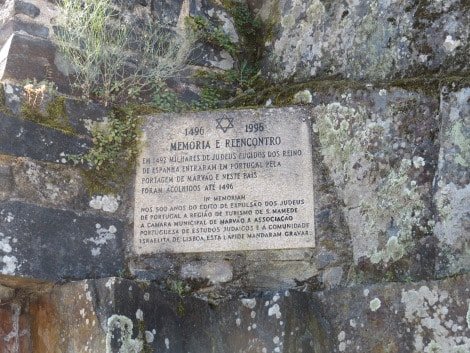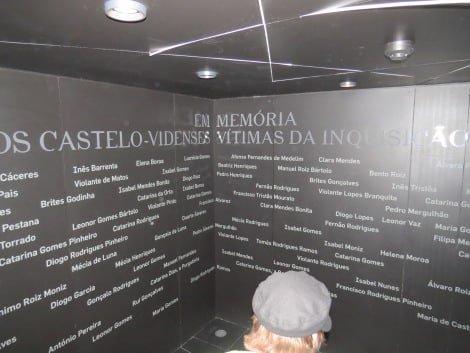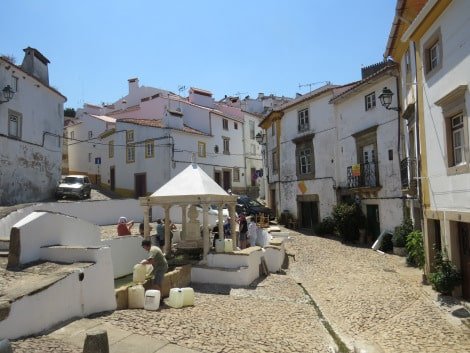This post will leave you stunned. I’ve returned to Portugal, this time with a group of 40 Jews from Israel and America. One place that we visited that was entirely new to me was Castelo de Vide. During my first trip to Portugal, everyone I met insisted that I visit this town. I was therefore thrilled to finally do so this time around, and it did not disappoint.

Bridge in Portagem

Located close to the Spanish border, this region was inundated with Jewish refugees at the time of the Spanish Expulsion in 1492. The refugees streamed across the border, and over the old Roman bridge in Portagem. A memorial sign now marks the location and commemorates the painful exodus.

Synagogue in Castelo de Vide

Inquisition Memorial in Caselo de Vide
Prior to 1492, eight hundred inhabitants lived in the border village Castelo de Vide, including a tiny Jewish community. However, after escaping from Spain, four thousand Spanish Jewish refugees settled in the town, swelling the population. Thirty years ago they discovered what is thought to be a synagogue. The municipality has since used the synagogue to create a modern and impressive museum. It serves as a memorial to the town’s Jews who suffered through the forced conversions of 1497 and the ensuing Inquistion. Over the centuries, the Portuguese Inquisition in Evora tried hundreds of the town’s New Chritstians for Judaizing.

Fountain in Castelo de Vide
Located at the bottom of the former Judairia (Jewish quarter) is the fountain that served as the baptismal font for forcibly converting the town’s Jews. It was here that Mario Soares, the former president of Portugal, issued an official apology to the Jewish people in 1986. Just around the corner from the fountain is a street that the Spinoza family lived on before escaping to Amsterdam in the early seventeenth century! The street is now renamed after the family that bore the famous philosopher.

Spinoza Street in Castelo de Vide.
The significant preservations are the result of the efforts of the town’s former mayor, Carolino Tapadejo, who labored on these innitiaves for over thirty years. He was kind enough to lead our tour, while Isaac Assor, the son of Lisbon’s previous rabbi, translated. The mayor, along with the majority of the town’s inhabitants are descendants of New Christians. Many still maintain a variety of Jewish customs such as cleaning their homes on Fridays and only making pork-free sausages. He told us that his family originally came from Toledo.

Me and Carolino Tapadejo
The most memorable moment of our visit came as a surprise, and left me speechless. Tapadejo told us that just in May 2015 he gave a tour of the town to an elderly woman from Netanya, Israel, named Esther Cohen. She told him that her family lived in Castelo de Vide before escaping to Constantinople in the early sixteenth century. They likely left in 1507 when the ports were finally opened to New Christians wishing to emigrate, following the massacre of three thousand New Christians in Lisbon in 1506. Upon her visit she showed him two keys. She told him that they were the keys to her ancestor’s former home in Castelo de Vide, held in her family’s possession for over 500 years! To our shock he then unwrapped the keys in front of us. Our group emitted a unified gasp as we witnessed tangible evidence of the ‘key story’ so often told of the Jews of the Expulsion. Our reaction provoked a strong emotional response in the elderly Tapajedo, who has worked so hard to uncover the town’s Jewish past. In front of us he began to cry. The keys are to be placed on display in the synagogue museum.

This experience reinforced for me the attachment that Sephardic Jewry felt for their ‘homeland.’ After leaving the Peninsula, Portuguese and Spanish Jews were always proud of their Iberian ancestry, and continued to preserve their languages and identities for centuries. The visit to Castelo de a Vide was a fitting conclusion to our Jewish heritage trip to Portugal. There we witnessed symbols of Portuguese Jewry’s enduring legacy. Despite expulsions and inquisitions, Spanish and Portuguese Jewries did not relent or forget their pasts. They are a testament to their heroic ancestors and to the unyielding Jewish spirit.
· by shalommorris ·
Source. SHALOM SAYS HELLO A blog of Jewish and (Western) Sephardic Interest
 eSefarad Noticias del Mundo Sefaradi
eSefarad Noticias del Mundo Sefaradi

